Does Our Boat Need a “Free” Energy Source?
The Inevitable Questions
Aside from “Are you going to carry a gun, you know because of the pirates?”, and “Are you going to home school?”, the third most common question I get from people who hear about our plan is “Are you going to install solar panels on your boat?” And until recently my answers were generally “No”, “Sort-of”, and “Yes”. First, I have no problems with guns in general, but carrying a gun on a boat outside the USA is logistically challenging regardless of its utility. Second, the experience of traveling is, in its own way, educational, so we’ll do a modified version of homeschooling we’ll refer to as boatschooling. Third, solar is undoubtedly useful and the general wisdom is that a cruising boat should have solar and/or wind generation to help keep the batteries topped up. I’ll leave the discussion about guns on boats for another day, and probably get something out about our boatschooling plans some day, but for today it’s time to share our initial plans for power generation.
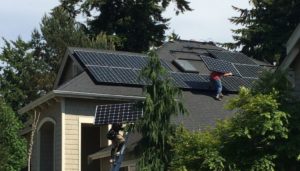
You Live In A Green State, with REI, and Subaru’s!
First, I am definitely a proponent of solar and other green power generation technologies, in fact we installed 10,000 watts of grid-tie solar on our Seattle-area home (blog post 1 and blog post 2), and one of our cars is an all-electric vehicle that we charge at home using a combination of our state’s hydro-electric generated power and the solar power from our roof. All of our lights are LED in our home (and on the boat), we have a learning Nest Thermostat, and outside lights are on timers. So we are certainly for green energy and energy conservation. As part of our cruising planning we maintain a list of all the things we believe we need or want to have for or on the boat. We periodically prioritize this list and then knock out the items on the list in priority order within each month’s available budget.
So Solar Then?
Installing solar panels on the boat has been very high on the aforementioned priority list from the beginning (safety items were higher of course) and I spent a lot of time researching just exactly what solar panels, charge controller, wiring, and mounting components we would need. As a DIY project, the cost of the entire setup for ~500 watts of solar will run about $1500 in parts. Having someone else install it would add significant labor costs to that figure.
But solar is worth it right? Free
energy straight to the batteries every day? What’s not to like?
The benefits of solar are pretty great and $1500 is not THAT much compared to other boat related items. And how else are we going to manage power crossing whole oceans? So it was a foregone conclusion that we’d install solar at some point before we take off next year.
Wait, Was A Foregone Conclusion?
In the meantime, we had planned our 2016 summer boat trip to Barkley Sound on West Vancouver Island, BC. We chose Barkley Sound for a few reasons..
- It’s reasonably close but we hadn’t been there before
- It’s highly recommended by other boaters who have cruised there
- We wanted some open ocean experience and getting to Barkley Sound puts you out in the Pacific Ocean for part of the passage

Drying Laundry in Barkley Sound - Barkley Sound is much less populated than the cruising grounds in the Salish Sea which will help test our provisioning, water consumption, fuel consumption, anchoring, weather planning, and other skills.
We blogged about the trip here of course and you can read all about it if you are interested, but suffice it to say it was fantastic. It also really solidified some of the assumptions we’d been making around food provisioning and power consumption for long-term cruising. Mobert doesn’t currently have solar or wind generation but it does have a high output Balmar alternator with multi-stage charge regulator on the engine and it has something that a lot of cruising boats don’t have–a large, permanently installed, diesel generator.
A Generator You Say?
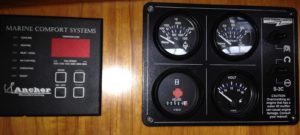
The generator (a Northern Lights 5kw unit in a sound insulating box) was installed by a previous owner for probably around $20,000 all-in, and being permanently installed it was naturally included when we purchased Mobert in 2014. We would never have spent that much money to install a generator if it had not already been there, but since we have it we use it for battery charging when away from shore power. The generator is far better suited than the engine alternator for charging batteries, and also allows us to power the water heater, charge laptops, and even run air conditioning when we want it (yes Mobert also has reverse-cycle air conditioning installed by a previous owner).
For charging our 450ah battery bank, the generator feeds two onboard battery chargers, a Xantrex inverter/charger that puts out 130 amps and a Cristec charger that puts out 60 amps. During our Barkley trip this summer we would regularly see 160-180amps of current going in to the batteries during charging. This means we could recover most of our battery capacity in 1-2 hours of charging. And in fact when I extrapolate our usage pattern in Barkley Sound out to a full month, the longest we’d likely be without some sort of shore support, it averages about 30 hours of generator runtime to keep our batteries charged, make some water, and take hot showers. We generally run the generator at about 2/5 to 1/2 load which equates to .25 to .5 gallons per hour. Some additional math nets that out to conservatively 15 gallons of diesel per month. Call that $45/month for fuel, could be more in certain parts of the world of course.
Won’t You Run Out Of Fuel?

Mobert carries about 95 gallons of diesel on board without carrying any extra jerry cans, so after the 15 gallons for the generator, we are left with about 80 gallons for running the engine if we need to get through a wind lull or maneuver around a harbor. Running our Yanmar engine at about 2100rpm, Mobert consumes about 1 gallon per hour and makes about 7 knots of boat speed. 80 gallons of diesel gets us over 500 nautical miles of range. We don’t plan to motor that far since it is, after all, a sailing vessel, but it’s nice to have some leeway to allow for powering through a dead calm to find wind again. All this means that we already have a very good source of power that is cost efficient to use and doesn’t appreciably limit our motoring range. Further, if we were to motor for a long period of time, the alternator would be charging the batteries at the same time and we would not run the generator during that time, so our motoring range would slightly increase the more time we spent motoring vs sailing.
To Solar or Not To Solar, That Is The Question..
Ultimately my position on solar has changed somewhat since we first started planning this trip. I could spend $1500 or so and quite a few hours of my time to install solar panels on the boat, or possibly more money adding a wind generator, or I could just use the generator that we already have, and use that $1500 to cover 2-3 years of generator fuel with no up front labor required. Because of this, we’ve decided to forgo solar and wind generation for the time being and just use what we already have that works.
That being said, we may find that we want solar in the end, and we can always add it later. And our decision to forgo solar is really the result of having a boat that already has a generator installed. If our boat did not have a generator, we would definitely add solar.
Oh, since we have the generator, jumper cables, a start battery for the generator, and more batteries for the bow thruster, I’ve removed the engine start battery and expanded the house bank to 600ah. It simplifies charging (no more ACR between the start and house bank, no more echo-charge from the Xantrex to the start battery, etc) and gives us much more leeway with battery capacity between charging cycles. In the event of batteries being too low to start the engine, we have multiple options depending on urgency of getting the motor started.
- We can run the generator to charge the battery bank back up, and then start the engine
- We have jumper cables that can reach from the genset start battery to the engine
- And we have a Noco 2000A Lithium battery jump starter in the ditch bag
But with proper monitoring of the battery charge levels we should not have any issues anyway.


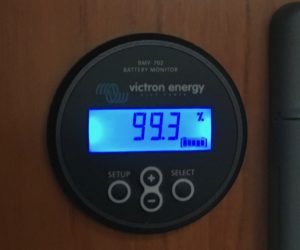 energy straight to the batteries every day? What’s not to like?
energy straight to the batteries every day? What’s not to like?
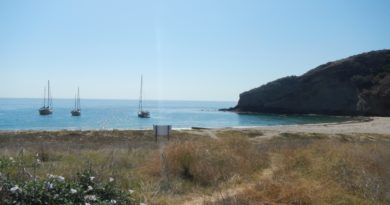

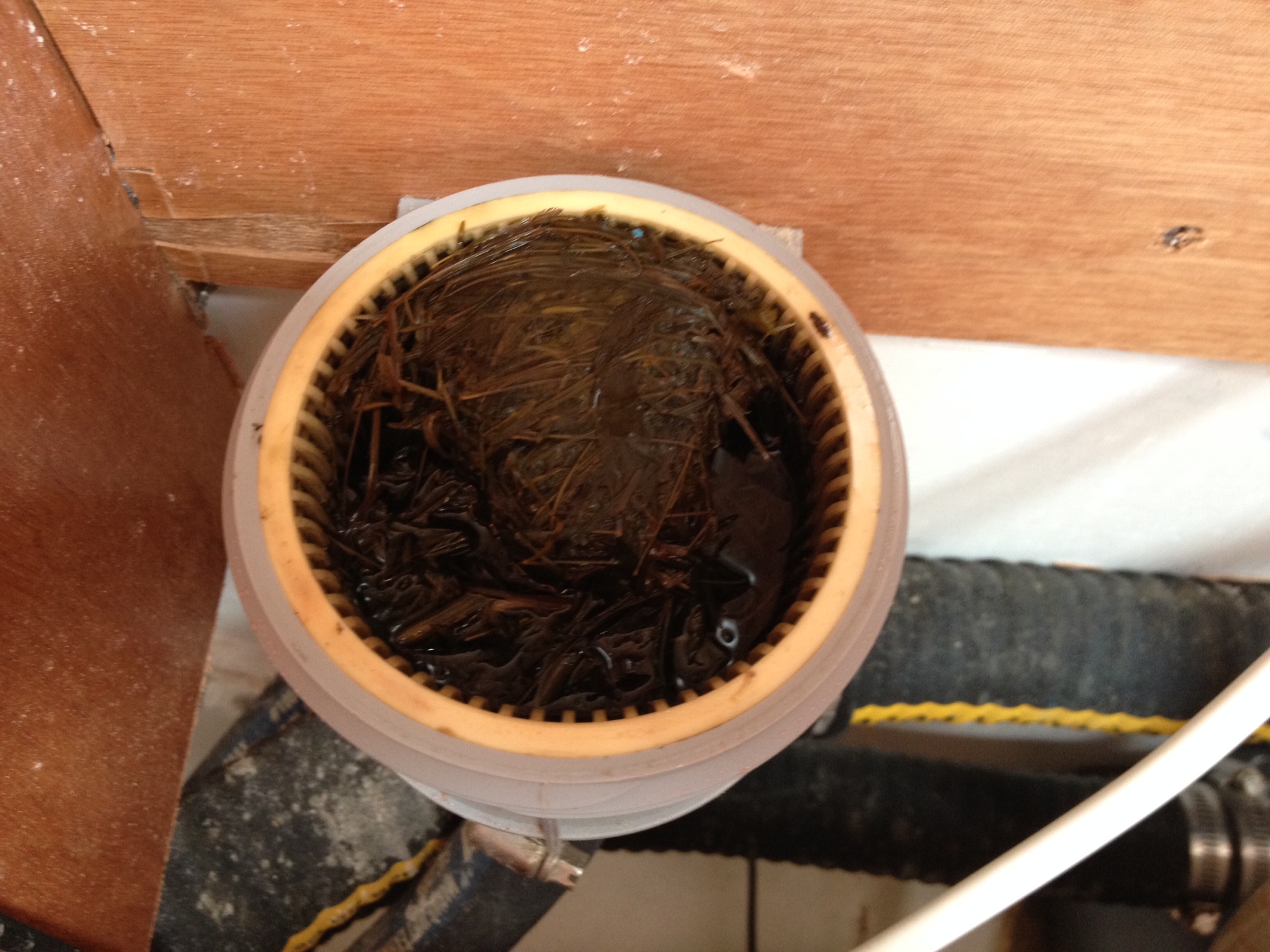
Pingback: Barkley Sound Trip Wrap up… – Andersons Abroad
We use wind, solar, genset, and water powered generator on our SO45, and it is still not enough at times. For the long crossings, you need all you can get if you are running two plotters, fridge and autopilot etc
I feel a little rude intruding on a stranger’s blog with advice, but anyhow — my family cruised for 3 years on a 39 foot catamaran, both ways across the Atlantic then across the Pacific. We had 400w of solar and a wind generator in addition to high output alternators on each engine. On passage we had to run the engines daily to keep up with the demands of the autopilot, but the wind and solar really came into their own at anchor. With sunny sky and tradewind breeze we could go a week without starting the engines. Many of our friends who started the trip without solar or wind added them along the way, for this reason. At anchor it’s really nice not to have to run a diesel.
Your planned itinerary brings back lots of happy memories. Have a great trip!
Matt, we’ve never done this before, so we love advice from those with more experience! It’s nice to meet you, and keep the experiential learning coming. 😉